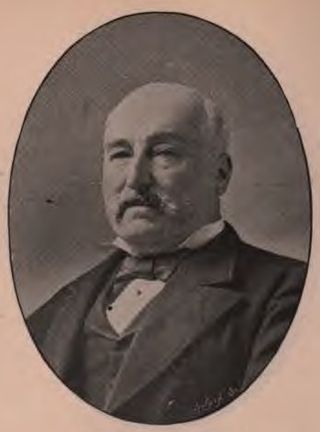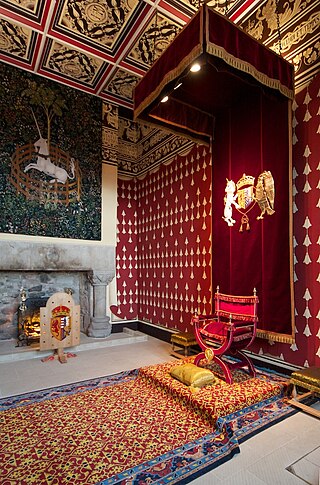Related Research Articles

William Cavendish, 1st Duke of Newcastle upon Tyne, KG, KB, PC, who after 1665 styled himself as Prince William Cavendish, was an English courtier and supporter of the arts. He was a renowned horse breeder, as well as being patron of the playwright Ben Jonson and the intellectual group known as the Welbeck Circle.

Tynemouth Priory and Castle is a historic site located on a promontory at the mouth of the Tyne at Tynemouth. The medieval Benedictine priory was protected by walls, towers, and a gatehouse. The heraldry of the metropolitan borough of North Tyneside includes three crowns commemorating the three kings who have been buried in the priory.

The history of Newcastle upon Tyne dates back almost 2,000 years, during which it has been controlled by the Romans, the Angles and the Norsemen amongst others. Newcastle upon Tyne was originally known by its Roman name Pons Aelius. The name "Newcastle" has been used since the Norman Conquest of England. Due to its prime location on the River Tyne, the town developed greatly during the Middle Ages and it was to play a major role in the Industrial Revolution, being granted city status in 1882. Today, the city is a major retail, commercial and cultural centre.

Ludovic Stewart, 2nd Duke of Lennox and 1st Duke of Richmond, Lord of the Manor of Cobham, Kent, was a Scottish nobleman who through their paternal lines was a second cousin of King James VI of Scotland and I of England. He was involved in the Plantation of Ulster in Ireland and the colonization of Maine in New England. Richmond's Island and Cape Richmond as well as Richmond, Maine, are named after him. His magnificent monument with effigies survives in Westminster Abbey.

Sir Charles Mark Palmer, 1st Baronet was an English shipbuilder born in South Shields, County Durham, England. He was also a Liberal Party politician and Member of Parliament. His father, originally the captain of a whaler, moved in 1828 to Newcastle upon Tyne, where he owned a ship owning and ship-broking business.
John Ingram was an English Jesuit and martyr from Stoke Edith, Herefordshire, who was executed in Gateshead on 26 July 1594, during the reign of Elizabeth I.
The Brandlings of Newcastle were a wealthy family of merchants and land and coal owners in Newcastle upon Tyne and Northumberland.

The Incorporated Company of Hostmen of Newcastle upon Tyne, often called the Hostmen's Company of Newcastle, is a company incorporated by royal charter of 22 March 1599/1600. Analogous to a livery company of the City of London, it still exists. It is best known to economic historians as a cartel of businessmen who formed a monopoly to control the export of coal from the River Tyne in North East England. They were so known from the medieval practice of "hosting", whereby local businessmen provided visiting merchants with accommodation and introduced them to local traders. The Hostmen acted as middlemen with whom the coal producers and those who shipped the coal to London and elsewhere were forced to deal.
Sir Richard Martin was an English goldsmith and Master of the Mint who served as Sheriff and twice as Lord Mayor of the City of London during the reign of Elizabeth I.
Captain Sir Thomas Liddell, 1st Baronet (1578–1652) was an English politician, a member of the Liddell family which monopolized the local government of the North of England during the 16th and 17th centuries. He was one of the leading supporters of the Royalist cause in the English Civil War.
Sir Peter Riddel was an English politician who sat in the House of Commons at various times between 1624 and 1640.

Henry Perlee Parker (1785–1873) was an artist who specialised in portrait and genre paintings. He made his mark in Newcastle upon Tyne in the 1820s through patronage by wealthy landowners and through paintings of large-scale events of civic pride. Over a period of forty years his work was exhibited at the Royal Academy and the British Institution in London. Coastal scenes of fisherfolk and smugglers were a popular specialism. Through the distribution and sale of mezzotint prints of subjects such as William and Grace Darling Going to the Rescue of the SS Forfarshire, Parker became one of the north-east's best-known nineteenth-century artists. In Newcastle upon Tyne he was central to the setting-up of a Northern Academy for the Arts. Later, in Sheffield, he taught drawing at the Wesleyan Proprietary Grammar School, and in his later years he lived in Hammersmith, London. He had a large family and was married three times.
Sir George Selby was an English politician who sat in the House of Commons between 1601 and 1611.

The Hawks family was one of the most powerful British industrial dynasties of the British Industrial Revolution. The Hawks owned several companies in Northern England and in the City of London all of which had the name Hawks in the company name, and which had iron manufacture and engineering, which they exported worldwide using their own ships, as their main enterprises. The Hawks family were involved in merchant banking, and in freemasonry, and in Whig free-trade politics. They developed areas of West London, including Pembroke Square, Kensington.

Walraven III van Brederode (1547–1614) was a Dutch aristocrat and diplomat. He was a son of Reinoud IV van Brederode and Margaretha van Doerne, and became Lord Van Brederode on the death of his father in 1584. He married Gulielma van Haeften.

A masque was held at the baptism of Prince Henry on 30 August 1594 at Stirling Castle. It was written by the Scottish poet William Fowler and Patrick Leslie, 1st Lord Lindores.

Jacob Kroger, was a German goldsmith who worked for Anne of Denmark in Scotland and stole her jewels.

The office of Sheriff of Newcastle upon Tyne existed from 1400 until local government reorganisation in 1974, and was reintroduced in 1996 as a title held additionally by the Deputy Lord Mayor of Newcastle upon Tyne. The city has a sheriff because it was historically a county corporate.
John Crane was a soldier and comptroller of works at Berwick-upon-Tweed during the reigns of Elizabeth I and James VI and I.

Richard Welford (1836–1919) was a British journalist, biographer, local historian, businessman and politician associated with Newcastle upon Tyne in the 19th century. He was the author of a number of well-known works of history of the area and of its leading citizens.
References
- ↑ Richard Welford, Men of mark 'twixt Tyne and Tweed (London, 1895), p. 120.
- ↑ Richard Welford, History of Newcastle and Gateshead, vol. 2 (London, 1884), pp. 90-1.
- ↑ Mary Anne Everett Green, Calendar State Papers Domestic, Addenda 1580-1625 (London, 1872), pp. 364-6
- ↑ Richard Welford, History of Gateshead and Newcastle, vol. 3 (London, 1890), pp. 91-3.
- ↑ Annie Cameron, Calendar State Papers Scotland, vol. 11 (Edinburgh, 1936), p. 418.
- ↑ Richard Welford, History of Newcastle and Gateshead, vol. 2 (London, 1884), pp. 244-5.
- ↑ John Nichols, Progresses of James the First, vol. 3 (London, 1828), pp. 280-1.
- ↑ Richard Welford, History of Newcastle and Gateshead, vol. 2 (London, 1884), p. 426.
- ↑ Richard Welford, History of Newcastle and Gateshead, vol. 2 (London, 1884), p. 425.
- ↑ Eneas Mackenzie, 'St Nicholas' church: Monumental inscriptions', in Historical Account of Newcastle-Upon-Tyne Including the Borough of Gateshead (Newcastle-upon-Tyne, 1827), pp. 256-275. British History Online